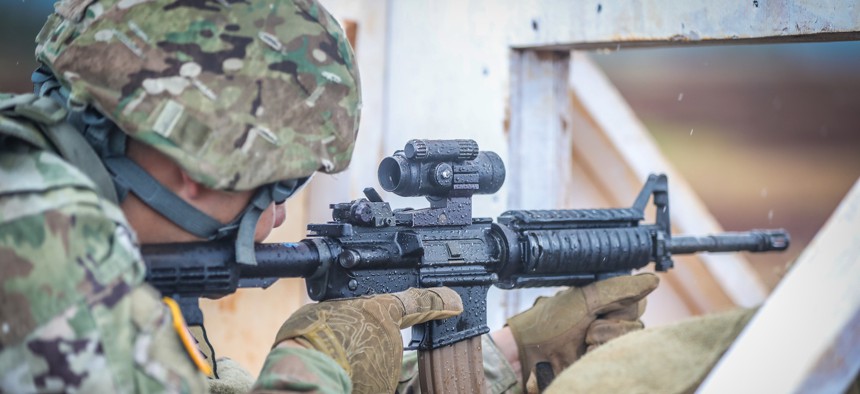
SCHOFIELD BARRACKS, Hawaii – Soldier with 25th Infantry Division Artillery “DIVARTY” gets ready to fire his M4 rifle during an M4 qualification range on Oct. 15, 2020 at Schofield Barracks, Hawaii. 25th Infantry Division / Spc. Jessica Scot
What the Army's Next App Reveals About Defense Innovation
A major wins an innovation award by proposing to bring hotel-style booking to training ranges.
When you use an app or a webpage to book a hotel room or an airline ticket, that room or seat immediately becomes unavailable to everyone else. It’s the sort of automatic system that airlines have relied on since the 1960s. But if you need to book time on a U.S. Army firing range, you’re stuck with a process that predates the Jet Age..
“Typically…there’s a lot of phone calls back and forth, a lot of centralized control,” said Maj. Evan Adams, describing the Army’s Range Facility Management Support System. “If you have to go through range control in order to figure out a phone number in order to coordinate with someone about a firing and do that three or four times because you’re trying to coordinate, it’s very difficult.”
On Tuesday, Adams won the inaugural Dragon Innovation Challenge, a Shark Tank-style event dreamed up by the XVIII Airborne Corps to find a better way to schedule range time. Adams pitched a new mobile range scheduling app that functions very much like a reservation app for a restaurant or hotel. It also includes satellite photos and additional information on the ranges themselves so that people looking to book can make sure that the course meets their needs. Army officials said the Airborne Corps would build and test the app.
In an interview, Adams modestly pointed out that the idea really just mimicked the kind of experience most iPhone users have come to expect. “My idea hinges on the fact that these technologies exist already. I mean, messaging boards have been around since I’ve been in college,” he said. “Nobody questions that kind of capability on Facebook or Orbitz… so scheduling shouldn’t be difficult at all.”
It’s an example of the sort of bottom-up approach to technology problems that military leaders say that they want to see more of. A second Dragon Innovation Challenge is scheduled for November. Adams said future versions of the app might predict when ranges are most likely to be busy, based on data provided by users.
But the Defense Department has a way to go in actually supporting innovative solutions from within the ranks, in part because it doesn’t do a good job of giving regular personnel the authority to work with outside software companies, according to experts who spoke to Defense One. Adams’s success hints at a massive culture shift that’s barely begun and is progressing too slowly, they said. Specifically, it’s a shift away from a system that empowers a small handful of program officers to buy things in bulk to distribute across the service. What may have worked well for ships, boats, and rations several decades ago is a barrier to solving IT related problems quickly in the year 2020.
Lt. Col. Matt Strohmeyer, an action officer with the Commander’s Initiatives Group at NORTHCOM, was a key player on a recent NORTHCOM effort to predict emerging COVID-19 hotspots across the United States and pre-deploy resources, a massive test of how well NORTHCOM could mobilize across the services to deal with a nationwide crisis. The effort relied on partnerships with a variety of software companies. On Wednesday, he described his experience working at the squadron level as an Air Force commander where he was charged with making squadrons more innovative. “We would see innovative companies that were doing things… bringing in 5G mesh networking” things that the Air Force needed to innovate squadrons.
But he encountered massive systemic obstacles simply to reaching out to IT suppliers, much less building new software. “It was everyday a battle of culture…. How you could work with the companies, rightly,” he said. “But then also the culture battle of using new technologies and then challenging our paradigms about how the government thinks about data, speed, change, go fast and fail forward, thinking about risk differently, taking prudent risk, taking an 80 percent (completed) solution out into the field and prototyping it.” (Strohmeyer cautioned that his views were indicative of his personal experience and did not reflect those of NORTHCOM or the Air Force, per se.)
Junaid Islam, the 5G security advisor at the National Spectrum Consortium, said “People like Matt [Strohmeyer] should be able to purchase IT products as an IT product” using tools that regular businesses use, as opposed to a weapons systems, which might appropriately come with additional restrictions and obstacles.
Tara Murphy Dougherty, CEO of Govini, said that the Defense Department needs to explore new ways to buy software in order to enable personnel at mid and lower ranks to actually work with the sorts of tools that entry-level workers at successful companies can use. “The standard for these types of things, data, software, should be licensing not owning… it gets back to culture and the fact that the default for when you’re writing a contract is to use DFAR clauses that assume the government has to own it all… The DFAR clauses in contracts should be limited rights where commercial IP is protected,” in particular, she said, the Department needs to look at new ways to rent or license software and data that can make apps like the one conceived by Adams more useful and functional. “The Department has a phenomenal understanding of its own data, a disastrous view of global markets,” she said.




